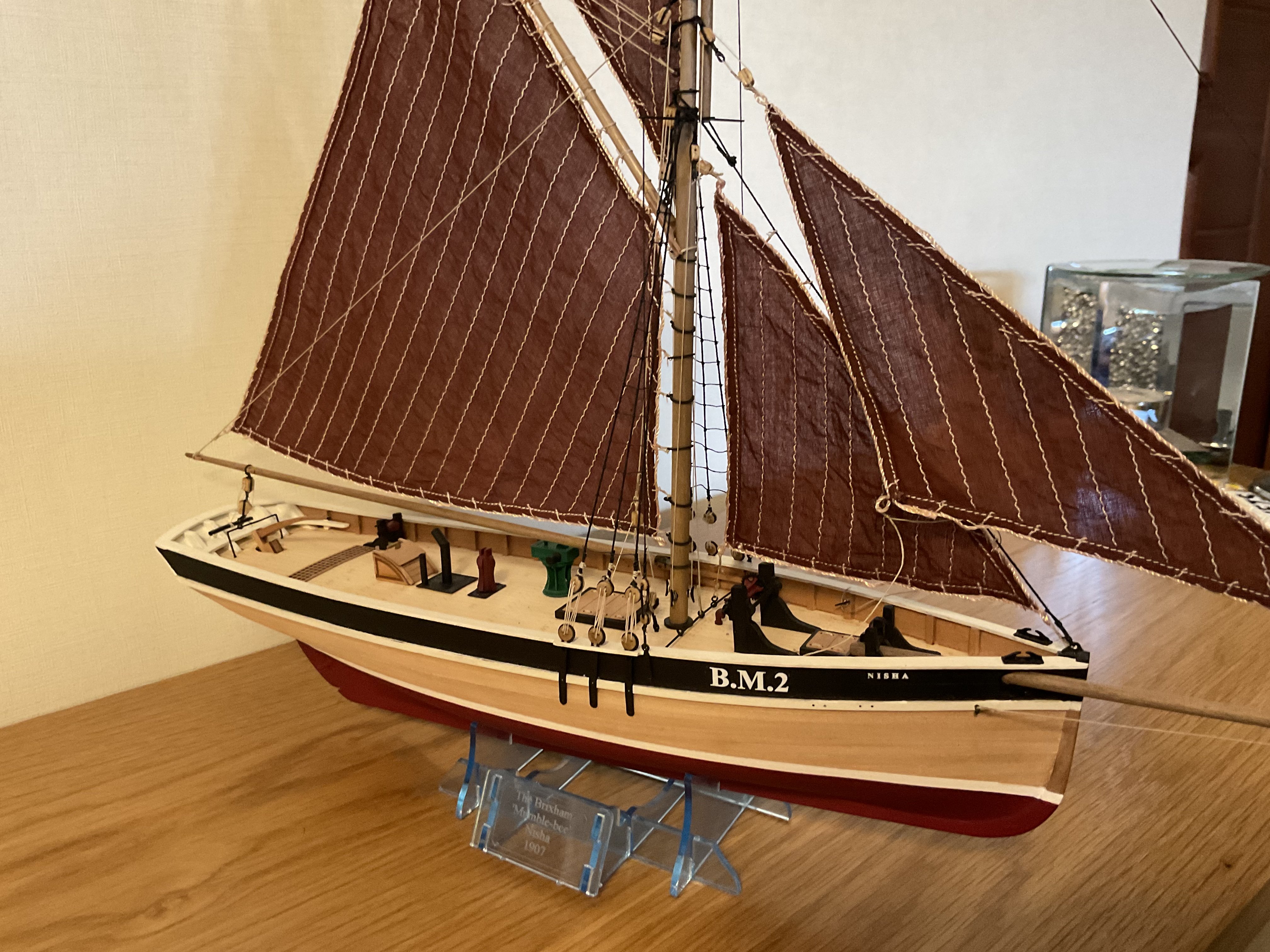-
Posts
480 -
Joined
-
Last visited
Content Type
Profiles
Forums
Gallery
Events
Everything posted by Craigie65
-
Hi Glenn, Looking excellent. For the rigging do you have rigging tools? I bought a set from CMB and find them invaluable in getting into hard to reach spots. Especially when paired with a fine pair of long tweezers.
- 62 replies
-
- Saucy Jack
- vanguard models
-
(and 3 more)
Tagged with:
-
Slow down Glenn! It’s at least 2 months before you get your Indy. This one is looking good and will be a nice addition to your fleet.
- 62 replies
-
- Saucy Jack
- vanguard models
-
(and 3 more)
Tagged with:
-
I use Veloset, which is a relatively fast setting woodglue. Find it gives you plenty of time to work the part, but sets quickly enough to see some progress. I buy it from Wonderland Models in Edinburgh, but I am sure it must be available elsewhere.
- 62 replies
-
- Saucy Jack
- vanguard models
-
(and 3 more)
Tagged with:
-
Hi Glenn, I found the planking on this one a bit more challenging. Did you taper the planks as well as edge bend? I struggle with getting the taper right. Each time I think I understand where I have gone wrong, but by the time I am ready to plank a new model I have forgotten the lessons learned. Looking forward to seeing the colours you have chosen.
- 62 replies
-
- Saucy Jack
- vanguard models
-
(and 3 more)
Tagged with:
-
It’s a difficult one. At this scale would you see the individual planks? Perhaps not, but at the same time I want people to see that it is planked and not just a preformed hull. Marco photography is ever the harshest critic. For me your hull is perfect. You are seriously tempting me to finish mine!
- 88 replies
-
- Erycina
- Vanguard Models
-
(and 2 more)
Tagged with:
-
Looking really good Glenn. That is the hardest part over. You will breeze through the ratlines, you would have had enough practice with Sphinx!
- 106 replies
-
- Erycina
- Plymouth Trawler
-
(and 3 more)
Tagged with:
-
Hi Glen, Do the top deadeyes need rotating to me a mirror image of the lower one?
- 106 replies
-
- Erycina
- Plymouth Trawler
-
(and 3 more)
Tagged with:
-
Thanks Dan, that is really kind of you to say so. I nearly want back to her the other day, but I am not far off finishing HMS Exeter - just those damn photo etched railings to go. You never know might just get her finished before Christmas. Andrew - I did see your logs. I had a stack of aircraft i tossed when we converted the garage to my office. I kept but three, one of which is my favourite of all time the Hurricane. A sadly underrated and overlooked beauty.
-
I sure you will move the sail up a bit to get the lower boom on the main. I think the ring it fits into needs to be glued to the mast. I found the rigging a bit simplified in places, but I guess the kit is aimed at a novice. I could have done a bit more research but TBH this kit was purely for fun and I loved every minute of building her.
- 106 replies
-
- Erycina
- Plymouth Trawler
-
(and 3 more)
Tagged with:
-
I am looking forward to the Indy being released. Not sure my wife shares that enthusiasm. 😂
- 106 replies
-
- Erycina
- Plymouth Trawler
-
(and 3 more)
Tagged with:
-
You will have this finished in no time. What is next on you list to build?
- 106 replies
-
- Erycina
- Plymouth Trawler
-
(and 3 more)
Tagged with:
-
Wow you are keeping busy! Nights must be drawing in in Scarborough
- 62 replies
-
- Saucy Jack
- vanguard models
-
(and 3 more)
Tagged with:
-
I had fun painting mine. Luckily they behaved themselves and remained attached to the double sided tape whilst spraying. Just needed to remember to mark the tape with “bow” and “stern”!
- 106 replies
-
- Erycina
- Plymouth Trawler
-
(and 3 more)
Tagged with:
-
It really does bring it to life. Have fun with the timber heads - lots of fiddly removal of char 😉
- 106 replies
-
- Erycina
- Plymouth Trawler
-
(and 3 more)
Tagged with:
-
Yip, this took me quite a while too. I tried to use a waterline marker, but found it too difficult under the counter. In the end I used the Mk 1 eyeball to run the masking tape before spraying the anti fouling coat. Decided that I was not going to have a boot top on this one.
- 106 replies
-
- Erycina
- Plymouth Trawler
-
(and 3 more)
Tagged with:
-
Looking good, but be careful, the plans are not 1:1. They are about 85%.. which reading properly you are aware of! Sorry
- 106 replies
-
- Erycina
- Plymouth Trawler
-
(and 3 more)
Tagged with:
-
Looking good, you are certainly cracking on with your biuld!
- 106 replies
-
- Erycina
- Plymouth Trawler
-
(and 3 more)
Tagged with:
-
Good warning - I used the plans for one mast and could not understand why it looked wrong when attaching all the cleats, eyelets etc. There was also bit of discussion on this when it came to the sails. @AJohnson was making his own. Turns out plans were reduced by about 15%. Anyway your build is looking great - the mast look very neat. Mine has stalled just shy of starting the masts. Tempted to leave it, but I do have the wonderful sails and it would be a shame not to use them.
- 88 replies
-
- Erycina
- Vanguard Models
-
(and 2 more)
Tagged with:
-
Numbs the pain of the midges 🦟 And the minuscule photo etch on my return to the dark side of plastic ships😱 (with apologies to Bowline for the detour on this excellent build)
- 88 replies
-
- Erycina
- Vanguard Models
-
(and 2 more)
Tagged with:
About us
Modelshipworld - Advancing Ship Modeling through Research
SSL Secured
Your security is important for us so this Website is SSL-Secured
NRG Mailing Address
Nautical Research Guild
237 South Lincoln Street
Westmont IL, 60559-1917
Model Ship World ® and the MSW logo are Registered Trademarks, and belong to the Nautical Research Guild (United States Patent and Trademark Office: No. 6,929,264 & No. 6,929,274, registered Dec. 20, 2022)
Helpful Links
About the NRG
If you enjoy building ship models that are historically accurate as well as beautiful, then The Nautical Research Guild (NRG) is just right for you.
The Guild is a non-profit educational organization whose mission is to “Advance Ship Modeling Through Research”. We provide support to our members in their efforts to raise the quality of their model ships.
The Nautical Research Guild has published our world-renowned quarterly magazine, The Nautical Research Journal, since 1955. The pages of the Journal are full of articles by accomplished ship modelers who show you how they create those exquisite details on their models, and by maritime historians who show you the correct details to build. The Journal is available in both print and digital editions. Go to the NRG web site (www.thenrg.org) to download a complimentary digital copy of the Journal. The NRG also publishes plan sets, books and compilations of back issues of the Journal and the former Ships in Scale and Model Ship Builder magazines.





